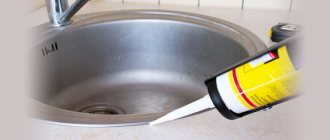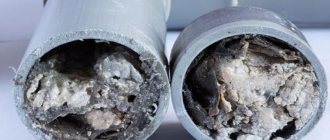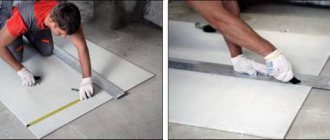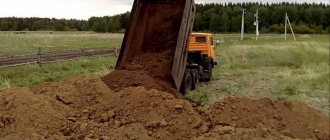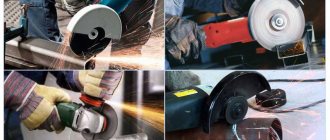Sooner or later, all owners of storage water heaters have a problem draining water from the tank. There may be several reasons for this:
- preservation for the winter at the dacha or after prevention of central hot water supply in the apartment;
- cleaning the tank from accumulated deposits;
- replacement of heating elements, magnesium anode and other repairs;
- use of water from the tank when the water supply is turned off.
Regardless of the reason, the water heater storage tank is drained according to the same algorithm.
Why can't you drain water through a faucet?
If you turn off the home water supply and fully open the “hot” faucet valve, a maximum of one to one and a half liters will flow out of the tap, and the tank will remain full. To understand the reasons for what is happening and subsequently properly drain water from the heating tank, briefly familiarize yourself with its structure and operating principle:
- The intake of heated water is provided from the upper zone of the tank - the end of the tube is located there. The supply from the water supply is organized into the lower part of the boiler.
Sectional diagram of an electric heating tank - A poppet-type check valve is installed at the inlet of the cold water supply (CWS) pipe, which prevents water from escaping back into the main. It also relieves excess pressure arising from heating and expansion of the liquid.
- When you use a storage heater (turn on the hot water tap of the mixer), water flows out of the tank under the influence of the pressure of the main hot water pipe.
- Without pressure from the main line, the system does not work - water itself does not flow from the tank. Only a small part of the liquid that was above the intake tube can be released through the mixer tap.
Note. The orientation of the tank in space does not matter; horizontal and vertical models are designed in the same way. The supply is at the bottom of the tank, the DHW extraction tube is at the top.
Internal structure and recommended connection diagram for the Ariston horizontal boiler.
Preliminary conclusion. There is no other option than to drain the water from the boiler through the “cold” pipe, since it is located near the bottom of the tank. The drainage method depends on the piping of the water heater; in some cases, the pipe connections will have to be disassembled a little.
Removing sediment
When to clean the boiler
Although there is nothing complicated in this process, we do not recommend doing it yourself. Many experts carry out sediment removal at the place where the water heater is installed, and some recommend removing it and performing all work on the floor:
- The first step is to remove the device casing.
- All electrical wires are disconnected.
- The union nut that holds the heating element is removed. To do this you will need a gas wrench. Please note that as soon as you begin to loosen the tubular electric heating element, water will immediately flow out from under its edge. And along with it comes mud sediment.
It is recommended to place a container under the drain so as not to stain the floors. Completely remove the heating element and clean it through the hole formed in the water heater. You can open the water shut-off valve slightly so that water gets inside the boiler. This will make washing faster and more efficient.
If you are completely satisfied with the process, we begin assembling Ariston according to the opposite scheme of assembly. A very important point is to install the heating element correctly and hermetically.
Relief via safety check valve
This method is recommended to be used by all well-known manufacturers of water heating tanks - Ariston, Thermex, Gorenje, Electrolux and so on. The household appliance is connected to the water supply networks according to the diagram (shown above) from the operating instructions:
- a safety group for boilers is installed at the inlet pipe;
- A shut-off valve is placed in front of the group;
- no fittings are provided at the outlet pipe or a ball valve is installed.
Explanation. The safety group is an automatic 3 in 1 element, it includes a check valve + safety valve + drain valve with a plastic lever.
Sometimes there are valves without a lever - you can’t drain water through such a valve.
How to drain water through a valve:
- We shut off the water main at the entrance to the apartment and disconnect the heater from the power supply.
- We release 1-2 liters through the nearest mixer, opening the DHW valve all the way. We leave the plumbing fixture in the open position so that air can fill the void in the tank.
- We place a bucket under the “spout” of the valve, turn the lever and slowly empty the tank.
Before emptying, the heating device does not need to be disassembled and wait for the water to cool. Disadvantages of the method:
- due to the small flow area of the spout (5...8 mm), the water drains too slowly, a boiler of 80-100 liters will be emptied in about 2 hours;
- the valve often becomes clogged and does not allow liquid to pass through well;
- sometimes the security group turns sour, the drain does not work at all.
The method is suitable for small water heaters of 25-50 liters, provided that the valve valve functions normally. It will take too long to release large volumes.
On the left in the photo is a clogged poppet valve, on the right is a measurement of the drain passage (5 mm)
Trouble-shooting
Having discovered a problem unit, you need to begin restoring the boiler’s functionality. The procedure depends on the specific reason that is interfering with the normal operation of the device. Let's look at the most common situations.
Scale clogged
Water heater clogged with scale
Scale is deposits of insoluble carbonate salts on the walls of water heating devices. It is found in kettles, washing machines, and water heaters.
The amount of scale depends on the hardness of the water. In regions with hard water, even after a year of operation of the boiler, the amount of salts deposited on the walls may be sufficient to completely block the lumen of the heating element tubes or significantly narrow it.
If scale causes the water heater to fail, repairs must be carried out in the following order:
- Open and remove the protective cover from the water heater.
- Unscrew the nuts holding the heating element in place and remove it.
Dismantling the heating element
Wash the boiler walls and heating element coil from carbonate deposits. Organic acid - lemon or oxalic acid - will help dissolve the hard crust. You can also use industrial products - anti-scale agents. Soak the part in an acid solution to free it from accumulated deposits.
Cleaning the heating element from scale
- Using a tester, make sure that the heating element coil has not burned out due to a violation of heat removal by scale.
- If the spiral is intact, assemble the device in the reverse order of dismantling.
If the heating element fails, you will have to look for a new one or buy a new boiler - you need to choose the most economical solution. If repairs require large financial expenses, it is more profitable to immediately purchase new equipment.
Failure of the pressure reducer
The pressure drops of the incoming water in the system can range from 2.5 to 7 atm. To compensate for surges, a special unit is installed at the boiler inlet - a gearbox. Its task is to ensure equal pressure at the outlet of the boiler and from the tap. If it falls due to a gearbox failure, it is necessary to adjust its operation or replace the broken part.
Low pressure in the main water supply also leads to a drop in pressure at the outlet of the water heating boiler or instantaneous water heater. Unscrew the hose and check the pressure level: if water comes from the main water supply in a thin stream or does not flow at all, you should wait, as the problem may arise due to repair work. If the pressure has not been restored within several hours, you should contact Vodokanal.
Thermostat failure
If the water leaving the boiler does not heat up enough or does not heat up at all, the cause may be a failure of the thermostat - it is responsible for maintaining a constantly high temperature. To carry out diagnostics, turn off the power to the boiler and remove the thermostat from the housing.
- Press the thermostat button.
- Heat the copper tip of the thermostat. If the node is working properly, the button should turn off.
- Test the electrical circuits of the thermostat using a tester.
Typically, a thermostat malfunction is caused by the overheat protection tripping. As a result of the operations performed, the device should work, and the problems will disappear after it is installed in place. If the tester shows an open circuit, you will have to replace the burnt out thermostat.
Faucet clogged
If water comes out of the boiler with sufficient pressure, but flows out of the tap slowly, the reason lies in the faucet being clogged with scale or rust. You will need to turn off the water, disassemble the faucets and thoroughly clean the filter mesh. You also need to inspect all the rubber seals and make sure that the valves are working properly.
Quick emptying via cold water pipe
To quickly drain water from a boiler connected according to factory instructions, you will need a pipe (gas) or adjustable wrench. We will disconnect the pipes, there is no other way. Procedure:
- We wait until the full tank cools down, or we turn it off and use the heated water as much as possible.
- We close the cold water supply to the house, release some of the water from the mixer, and leave the tap open. Again, turn off the power supply to the water heater.
- Using a gas wrench, unscrew both connections to the boiler. It is worth placing a bucket so as not to flood the floors and other objects under the water heating apparatus.
- Use the key to grab the edges of the valve and slowly unscrew it. Use your finger to close the hole in the “hot” pipe, otherwise air will pass freely into the container and water will flow out.
- We finally twist the safety group, place a bucket below and release the finger. If you need to stop the flow, plug the hot water pipe of the boiler again.
- Before assembling and filling the tank, thoroughly clean the pressure relief valve (preferably blow it out).
Advice. It is more convenient to carry out manipulations when there is a tap at the outlet fitting. You can find a valve with a ½” (internal) thread in advance, screw it on instead of the removed pipe and regulate the air supply/water flow.
The advantage of this method is the speed of emptying; the procedure will take a maximum of 30 minutes. Negative points:
- disassembly is required - you need to remove at least the cold water pipe;
- the water heater must be cooled, otherwise you will get burned;
- the pressure from the fitting is difficult to control, the vacuum does not work immediately.
The flow of water can be slowed down - do not disconnect the hot water supply line from the boiler. Air flows through the mixer more slowly and the flow is intermittent. How to drain an Atlantic 80 liter water heater, watch the video:
Useful tips
In order not to damage water heating equipment when cleaning it yourself or replacing faulty parts, you must adhere to the following recommendations from specialists:
- any work related to the maintenance of electrical equipment is carried out only when it is completely de-energized;
- You must first study the instructions from the manufacturer, which indicate the design and procedure for assembling/disassembling the device;
- If unpleasant odors begin to appear when using the boiler, once every 2 months you need to run 100 liters of clean cold water through it.
Draining liquid from an Ariston water heater is easy to do if it was installed according to the manufacturer's instructions. It is not recommended to change the device connection diagram yourself. This may not affect the operation of the equipment itself, but it will definitely complicate future maintenance.
Using a trim with a drain valve
The method significantly simplifies the procedure for emptying the water heater. One condition: the piping diagram must have a drain valve installed on the tee after the relief valve, as shown in the picture below. Next is a matter of technology:
- We cut off the cold water pipeline with a valve, turn off the power supply, and open the hot water on the mixer.
- We attach a hose of the required length to the drain tap fitting and prepare a bucket.
- Open the valve and drain the contents in portions.
There is no need to disconnect the pipes; if necessary, the flow can be easily stopped with a tap. The hose does not spray because the mixer restricts the flow of air into the tank. A 50 liter water heater is emptied in 10-15 minutes.
The piping diagram does not show drainage from the relief valve to the sewer system
Important point. Manufacturers of water heating equipment do not welcome this piping option. Reason: there is a tee with pipeline fittings between the safety group and the boiler, which is not allowed by the rules.
Practice shows: installing an additional valve does not pose a threat if the user does not drain sanitary water when the heater is on. In this case, the level in the tank decreases, the water heating element can “surface”, overheat in the air and quickly burn out.
The second condition: the tee must not become clogged, otherwise the path to the relief valve will be closed. Then, when heated, the expanding liquid will rupture the hot water pipeline or the container itself.
How to troubleshoot
If the cause of the leak is a faulty valve, then it is replaced with a working part adjusted to the same operating pressure. When replacing, or better yet, while installing a water heater, try not to use cheap Chinese products. Remember that the safety of your family directly depends on the valve. Good Italian safety valves with the same non-separable design, although they cost several times more, are purchased once. As practice shows, there are no problems with them in the future. Connect a flexible transparent hose to the drain outlet of the device. This will help you visually evaluate the performance of the part. Lead the end of the hose into the sewer or a suitable container.
Draining from an indirectly heated floor boiler
We will talk about floor-mounted water heaters, whose pipes go up. Other models are equipped with a special drain fitting and are emptied without problems.
Important! The secret to successful draining of a floor heater is the correct piping pattern. The end of the drainage pipe and the shut-off valve must fall below the body of the apparatus, due to which the law of communicating vessels operates.
How to drain water from an indirect boiler with top fittings:
- First of all, cool the container to an acceptable temperature of 25...40 °C.
- Shut off the heating and hot water supply lines and open the water intake valve.
- Make sure that the drainage channel is filled with water - open the drain valve slightly.
- If the channel is empty, turn on the cold water supply and wait until it flows from the drainage tube. Turn off the water supply again. Then the emptying of the “indirect tank” will begin thanks to the law of communicating vessels - drainage will pull all the water out of the tank.
- When the drainage line is full, draining the tank is even easier - open the valve all the way and watch how the liquid leaves the tank.
Since indirect water heaters can hold 100...500 liters, the procedure will take a lot of time - from 30 minutes to 2 hours. The essence of the method will once again be explained by a representative of the ACV company, which produces similar boilers:
Can I fix the problem myself?
Troubleshooting a water heater requires the user to have experience working with water heating equipment. This will help him not to confuse anything and actions to correct breakdowns will not cause even bigger problems.
If there is no such experience, then when dismantling various parts of the water heater, disassembling its parts and components, it is better to invite a specialist involved in the repair of devices of this class and brand. The measures are related to the fact that different models of devices from different manufacturers necessarily have significant design and functional features and their own specific functioning. This applies to both the appearance of the device and the features of the configuration, the layout of its internal parts and elements.
For example, one well-known company decided to equip its water heaters with connecting elements in the form of self-clamping clamps, while another uses nuts to connect pipes, and the use of anything else, in this case, will be useless.
In heating devices from other companies, the spiral of the water heating element is placed in a hole with a diameter of 65 mm. To attach it to the tank, special tools are needed, and the screwed-in bolts are so tightly connected to the nuts that it is simply impossible to unscrew them even if you try. As a result, when something in the device fails, it will not be possible to quickly open its case. In addition, all fastening parts, and there may be more than 12 of them, will have to be removed with a grinder, and the likelihood that by removing the bolts, you can also remove part of the body at the same time is very high. In addition, a boiler is an electrical device, and in order to work with it, you need to know which wire should be connected to which element. Not knowing and not following safety precautions when working with electrical devices can lead to dangerous consequences, the most harmless of which will be a short circuit in the electrical wiring.
If there are interruptions in the operation of the boiler, you cannot do without contacting specialists because difficulties are caused not only by the breakdown of parts of the device, but also by external factors that are in no way dependent on either the user or the device that he is trying to fix on his own.
However, it is necessary to carry out preventive maintenance of the device from time to time: change filters, inspect the internal tank for leaks and possible damage, check the integrity of the electrical wiring, at the slightest suspicion that the device is not working correctly. In the event of a breakdown, contact the service center to troubleshoot. Then the water heater will last a long time and it will be safe to use.
Do I need to dump water and when to do it?
It doesn’t always make sense to empty the reservoir of a household appliance. For example, in the event of a breakdown of the automation unit - sensor, thermostat - replacement is carried out without complete disassembly, there is no need to drain the water. In what situations is defecation done:
- for the winter in an unheated building - a country house, a bathhouse, etc.;
- before cleaning the heating element, washing the container from the inside;
- when it is necessary to change the magnesium anode;
- in case of moving the boiler to another location or completely replacing the water heating device.
Advice. To get rid of stagnant water and bacteria (in particular, legionella), it is enough to “fry” the device at maximum mode at a temperature of +75 °C for an hour. Then update the contents of the tank.
Let us remind you how to properly dial a water heater. We open the cold water valve, the “hot” tap and wait. When the container is full, water will flow through the intake pipe into the hot water system and then flow out of the mixer.
Why does the boiler cool down quickly even though we recently bought it?
First, let's look at the simplest reason for a recent purchase. If you recently purchased a water heater and have not used it before, then we must warn you about some interesting points.
A good 80-liter water heater, fully heated (this can be understood by the indicator), should freely allow 3 adults to wash themselves in the shower, and at the same time the latter will no longer have hot water flowing. Why is that? We actually waste a lot of water when we bathe, so the system is designed in such a way that cold water is supplied from below, and hot water is taken from above (even if the supply visually comes from below). Therefore, when there is less and less hot water, some of it mixes with the lower layers of cold, and cool water comes out.
Even if you were told that now you can wash with almost five of you, you were deceived. Now many people are complaining about the insufficient power of their water heater, and it turns out that they were told fairy tales in stores.
Why does the boiler cool down quickly after moving or after reinstallation?
If you moved this water heater to a new apartment, or it was installed by “insufficiently qualified technicians,” there are some errors that may affect its operation.
- The most common reason why the boiler cools down quickly is incorrect connection of the water supply and outlet hoses. In this case, the water will heat up, but it will cool down much faster, since cold water will fill the system from above, and according to physics, will move down to the outlet. Therefore, after some time, you will no longer be able to wash normally, even though hot water will still be in the system.
- In addition, the concept of “water too cold” is often observed. In winter, the water entering the system is almost icy, and in summer it is slightly warmer. If before the three of you washed normally, but now the third one barely has enough time, know that this is the reason. If the three of us washed normally before, but now the first one doesn’t have enough, then most likely this is not the reason.
- It is also worth checking the pressure in the system. Often more cold water can be supplied, or rather the pressure can be much greater than necessary, and the drainage system can pump out warm and hot water to avoid rupture of the tank. This happens in extremely rare cases, especially if you installed the system using wizards. Although it is rare to find this, even if you installed it yourself.
- Sometimes, sudden cooling is possible due to the lack of shut-off valves at the hot water outlet. This is a common installation error, so if you did the installation yourself, you may want to take a look at this problem. In this case, hot water may partially go through the system to your neighbors if you live in an apartment building.
- The heating element is dirty inside. For the device to work properly, the tank must be opened and cleaned at least once a year. If it has not been cleaned for about 2-4 or more years (the period may be less due to the quality and type of water), the reason may be that a lot of sediment has accumulated on the water heating element, which interferes with normal operation. In this case, you just need to clean the water heater.
These are the main reasons why the boiler cools down quickly. Only a master can really try to solve the problem in this case, especially if the above methods did not help.
Boiler problems:
- the thermal insulation has burst or broken;
- the entire structure is installed on the roof (attic) of the house, so it easily cools down due to the external temperature;
- The water heater itself is defective.
But this happens extremely rarely. The reasons described above occur more often. You can solve it yourself if you understand the problem a little, but if not, then leave a request to the specialist.
Precautionary measures
Before draining the boiler, be sure to follow the following precautions:
- Turn off the power and allow the water to cool . Agree, pouring boiling water is not only uncomfortable, but also dangerous, as you can get burns. If you plan to drain the water in the morning, then turn off the water heater at night.
- Perform all work only with the plug disconnected from the socket . The boiler must be de-energized before you begin to perform various manipulations with it.
- Do not remove a boiler that is filled with water , as this is difficult and the process of draining the water may be difficult.
- Turn off the cold water supply using a special tap, otherwise you will never achieve complete emptying, since the principle of operation of the boiler allows it to dispense hot water while simultaneously pumping in cold water.
- Find a container where the water will be drained and prepare it in advance.
Expert opinionGrebnev Vadim SavelievichHeating system installerBe sure to study the design of your boiler and carefully read the instructions. Each model has its own design features, on which the further sequence of actions depends.
Ariston water heaters
The first 3 stages of the action execution algorithm are quite similar to the operations described above.
Next you need to proceed like this:
- Open the straightener located on the water pipe with hot liquid. This operation will ensure that air enters the tank.
- Connect the hose to the pipe that supplies cool water to the water heater. Take it to the sewer system. It is allowed, for example, to place its end in the bathtub. It is necessary to secure it so that it does not jump out of it during draining.
- Open the oil drain valve located on this pipe and drain the liquid.
Instructions
The process of draining water from boilers of different manufacturers is almost identical, with the exception of some nuances. Before emptying your Thermex water heater, it is recommended that you do some preparatory steps. First of all, the device is disconnected from the power supply. This measure is necessary for safety reasons, otherwise the equipment may fail and the person working with it may be injured.
It is also necessary to turn off the water supply taps in the house so that water does not flow into the tank. The equipment is left untouched for some time so that the water in the container cools down.
As mentioned earlier, Thermex boiler models vary in shape and size. Flat devices of large volume are equipped with two holes for the supply and outflow of water, to which tubes are attached. Before draining water from devices of this type, the tubes must be removed. Thermex water heaters of small volume and round shape work on a different principle. In order to empty this type of device, it is enough to turn off the cold water supply and pour out any remaining liquid from the tank.
Sources:
- https://sovet-ingenera.com/otoplenie/vodonagrevatel/kak-slit-vodu-iz-vodonagrevatelya.html
- https://kamin-expert.ru/elektricheskie-boyleryi/kak-slit-vodu-s-bojlera-metody-ih-osobennosti-preimushhestva-i-nedostatki.html
- https://vanna-expert.ru/boylery/kak-slit-vodu-s-vodonagrevatelya.html
- https://otivent.com/kak-slit-vodu-s-vodonagrevatelja
- https://remont-system.ru/vodonagrevateli/kak-pravilno-slit-vodu-iz-nakopitelnogo-vodonagrevatelya
- https://SantehnikPortal.ru/vodosnabzhenie/slit-vodonagrevatel.html
- https://kvanta.ru/vodonagrevateli/3-sposoba-kak-slit-vodu-s-thermex
- https://stroy-podskazka.ru/vodosnabzhenie/vodonagrevatel/slit-vodu-iz-thermex/
